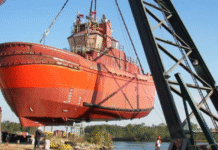‘…Bangladesh is really an ‘emerging economy’ if you see at its Forex reserves this year. We’re negotiating with the government for providing loans ranging from $1.8-$2 billion which is almost twice than the last year,’ said director general of ADB’s South Asia Department Hun Kim in Japan on Sunday.
Hun Kim was responding to a volley of questions from a group of journalists on the last day of the 50th Annual Meeting of the Board of Governors of ADB held at the Pacifico Yokohama Conference Centre. Deputy director general for ADB’s South Asia Department Diwesh N Sharan was also present there.
The DG said the ADB itself will provide $650 million for a single project on power transmission and distribution in Bangladesh alongside continuing its assistance for railway and road connectivity taking up the overall assistance to over a billion dollar.
‘As far as we’re concerned, Bangladesh is doing right in terms of economic policy and implementation because we’re focusing more on manufacturing and export orientation,’ Hun said.
Responding to a question from a Bangladeshi wire service journalist, Hun said his growth projection about Bangladesh is the longer run one. ‘I wouldn’t say about any certain point. But, I think, Bangladesh should continue 7 per cent (GDP growth).’
About ADB’s this year’s commitment, he said, ‘Last year, the ADB’s assistance to Bangladesh amounted to $1.1 billion, and there is going to be a big jump this year with $1.8 billion.’”
Turning to Bangladesh’s power and energy sector, Hun Kim said there is still a lot to work on operation-based generation capacity, transmission lines alongside boosting the road connectivity.
Hun, however, pinpointed that Bangladesh is rather weak in mobilising Foreign Direct Investment as the FDI flow is very small to the country which accounts only less than one per cent of its total GDP size.
He said Bangladesh alongside Sri Lanka has been the biggest beneficiary of capital increase over the years and the annual lending to Bangladesh used to be around $ one billion per year. ‘But, I believe, it can easily go up to $ 2 billion. So, this year, we’re almost approaching that level, based on the project readiness, we can make that commitment.’
Hun said they see three major initiatives in Bangladesh and one is transport logistics as Bangladesh is becoming a regional hub and the second one is energy security.
‘And the last major initiative is to develop the manufacturing growth centre. If these three things are combined and aligned, I think, Bangladesh can continue 7-8 per cent growth that the East Asia achieve. Bangladesh, I think, is close to the East and East Asia’s success model at this stage.’
Talking about the high-quality labour force potential in Bangladesh, he cited that upgrading skills of the manpower and the workforce could be the ultimate challenge before the country.
Asked about the status of the private sector lending by the ADB, he said the lending agency is negotiating a deal with the government in the transport sector to promote Public Private Partnership since opportunities are there.
Bangladesh joined ADB in 1973. As of 31 December 2016, ADB’s cumulative lending to Bangladesh stood at $18.3 billion for 269 loans, $252.4 million for 422 technical assistance projects, and $787.10 million for 35 grants.
As of 31 March 2017, ADB’s projects under implementation for Bangladesh comprised 90 loans and grants amounting to $7.6 billion; and 32 technical assistance projects amounting at $28.58 million.
ADB focuses its support to Bangladesh in six sectors— energy, transport, water and other urban/municipal infrastructure and services, education, finance, and agriculture, natural resources, and rural development. In 2016, ADB approved 10 projects for Bangladesh, with loans totaling $1.1 billion and technical assistance of $7.85 million.
Source: New Age









